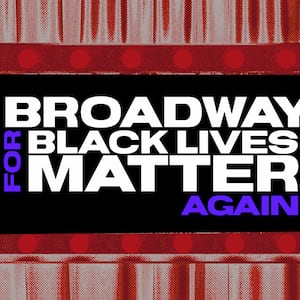Dede Ayite recently became a first-time Tony Award nominee, twice over. The Ghanaian-born costume designer is nominated for her work on Slave Play and A Solider’s Play, two of the 18 Tony-eligible productions in a season cut short by Broadway’s March closure.
It’s a surreal time to celebrate the honors, given the state of the world and the theater business (perhaps one reason the streaming ceremony has yet to be scheduled). But it’s also an especially poignant one for Ayite, who has joined fellow artists in thinking deeply about how to create equity in the industry, and whose work also happens to demonstrate, in its pursuit of truth, the breadth and vibrancy of Black stories.
“I feel joyful, of course,” Ayite (pronounced “ah-yee-tay”) told The Daily Beast of the nominations, over Zoom from her New York apartment. “I feel humble and gratified, but at the same time it’s conflicting for me. I'm still trying to navigate and reconcile the idea that there's so much pain happening right now, and potentially more to come.”
Broadway will remain shuttered until June 2021 at the earliest, when it will have been a year since the eruption of global protest over anti-Black racism and the ensuing reckonings with race that have spread across industries, including New York theater. Ayite is circumspect in considering theater’s role in broader cultural conversations about Black lives.
“Illustrating that Black people are human and are worthy regardless of how you might perceive them, that matters to me,” she says. At the same time, Ayite does not consider offering such proof as part of her job or what drives her as an artist. “I'm not doing a show in order to prove to anyone that I matter enough,” she says. “Even the idea of ‘Black girl magic,’ in some ways it's problematic. I don’t need to be magical for me to matter. I don’t need to be extraordinary by your standards. Of course I’m magical; I’m human.” Hopefully, people come to the theater because they’re already open to empathizing with experiences outside their own, she suggests.
“When it comes to storytelling, what brings me the most joy is an attempt to find some sort of truth, or to tap into aspects of society that we, as Black people or as people [more generally], might not have considered or necessarily experienced,” Ayite said. “I'm also trying to disrupt that idea that the Black experience is a singular story.”
The two Broadway productions Ayite helped bring to life this season were exemplary of her artistic tenants.

Joaquina Kalukango and Paul Alexander Nolan in 'Slave Play'
Matthew MurphyJeremy O. Harris’ Slave Play, now the most nominated play in Tony history, incited fiery conversations about sex, power, and the traumatic legacies of slavery, breaking through to the zeitgeist in a way not often achieved by a Broadway production.
The play presents a major design challenge. Its first scene finds three interracial couples dressed in what seems like antebellum garb, acting out sexual encounters wherein one of the two partners appears to be enslaved. It’s not until deep into the play’s first act that we discover they’re modern-day characters participating in elaborate role play.
“What was important as a costume designer was to set people up so they felt like it could be real, but just enough little things were off that they knew something was amiss,” Ayite says. “I couldn't get ahead of the audience and take away the experience for them.” That meant subtle details, like the modern style of head wrap worn by Kaneisha (played by Tony nominee Joaquina Kalukango) or leather boots worn by her partner Jim (Paul Alexander Nolan) that looked period but were modern as well.
An ornate dress worn by Alana (Tony nominee Annie McNamara) in the opening scene is one example of how Ayite sought to weave the play’s racial and sexual power dynamics directly into the garments on stage.
The fabric’s colorful embellishment would not have been quite right for the period, Ayite said, but she aimed to demonstrate how much (and whose) labor went into its construction. “I’m hoping to give the audience a slight window into the European standards of beauty that [Alana] might be taking on,” Ayite said, “while acknowledging that this fabric came at a certain cost,” namely the slave labor that would have transformed raw cotton into pretty fabric.
The dress came off to reveal shiny black dominatrix gear, a more obvious period departure that reflects another aspect of the power play between Alana and her Black partner, Phillip (played by Sullivan Jones). Alana has the privilege that comes with being white, Ayite says. “But then as a woman, she’s taking ownership of her sexuality and finding a way to speak for herself.” The scene finds Alana dominating her partner in bed (purportedly to address his racial trauma).
“I'm not there to judge the character,” Ayite said. “I'm there to identify what that character holds most true to themselves, and then try to emulate that through the costumes without giving too much away.”

Jerry O'Connell and Blair Underwood in 'A Soldier's Play'
Joan MarcusA Soldier’s Play, Charles Fuller’s 1981 Pulitzer Prize-winning drama about Black American soldiers awaiting deployment during World War II, presented a wholly different sort of challenge.
The all-male cast, including stars Blair Underwood and David Alan Grier, wore military uniforms throughout. Ayite pored over historic imagery to accurately represent not just the clothes themselves, but how each character would have worn them and styled their hair, depending on status and personality.
“For me, every character matters and has some sort of story, whether they're featured or not,” Ayite said. “I'm hoping to illustrate that in my costumes by adding more detail.” In this case, that led to conversations with actors about what religion and birthdate they wanted printed on their characters’ dog tags, for example.
“My job is to find my way in and try to get an understanding of where that [actor] is coming from, and how I can combine that with what our intention is for the show so they feel comfortable, because ultimately they have to be on stage,” Ayite says. Collaboration with directors and the whole design team is also key from the start, Ayite said. “I don't work in a singular way.”
Ayite studied design at Yale School of Drama, having moved to the states from Ghana for high school in 2001. (The correct pronunciation of “Dede” in Ghana is “day-day,” but most people call her by her nickname “Deedee.”)
She majored in behavioral neuroscience during undergrad at Lehigh University, and brings her expertise and fascination with psychology to her work. “I'm interested in who we are and what makes us tick as human beings,” Ayite said. That curiosity serves both her explorations of character and her working relationships within the industry.
With live theater largely on hiatus, Ayite has teamed up with fellow designers to form a group called Design Action, which arose in the wake of this summer’s protests to address racism in the community and ease the pipeline for incoming designers of color.
“Our main focus right now is trying to get an understanding of what issues [rising and early-career designers] are facing, what traumas they might have, and how we can alleviate some of that and create space for them,” Ayite said. “How can we create equity for all of us? There are so many layers to that, but the first step I think is harm reduction.”
Ayite’s perspective on race and privilege has been shaped by her experience growing up in Ghana before moving to the states as a teen. “Because of my background and upbringing, when I first came here I don't think I quite understood what was happening,” she says of white people’s perceptions of her as a Black woman. “This happened a lot when I first moved, people would say: ‘Oh, you do so well in school,’ or, ‘You speak so well.’ It's like, ‘Okay, well, why not?’”
Having built a career in American theater, she’s experienced the tightrope walk that many artists of color, and Black women in particular, point to as typical of the industry.
“There have been times I walk into the room and recognize that I'm the only Black person here,” Ayite said. “So I have to make sure that I am on point. And I'm always toeing the line of not being the ‘angry Black woman,’ but also being firm about what my needs are. How do I get my voice across, to then not come across as angry or arrogant? That's something a lot of people don't have to navigate.”
Clearing a path for other designers, hoping they may face fewer of the same challenges, feels especially important to Ayite. “Being grateful to those who sacrificed, and who it cost something to open the doors for me to be where I am today, I'm definitely cognizant of the fact that I have to do the same for those coming after me,” she said.
It’s a principal engrained in her from a young age, and embodied by the Ghanian Adinkra symbol Sankofa, which means “remember the past and move forward.” Her father gave her a pendant with the symbol when she was 16. “Growing up, that has always been with me.”
Ayite said she had “no future plans” she could share, “but I am keen on utilizing this time to reflect on ways I can create a healthier and sustainable approach to theatre. I’m thinking a lot about access and opportunity within my community.”
The prolonged industry pause has provided the time and space for artists like Ayite, and groups like Design Action and Broadway Advocacy Coalition, to question individual responsibility and how to work toward greater equity, especially for artists facing anti-Black racism.
“How am I able to capitalize on the relationships I have to create space, or to identify actions that we can take to create access and opportunity for others?” Ayite said. “Who is theater for? If it is for all of us, then how does what we're doing backstage or on stage reflect the culture or community that we exist in?”
It’s a question the whole industry needs to reckon with before curtains rise on the next Tony-eligible season.







